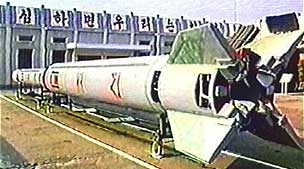The United States has recently informed Japan that the Taepodong-2 missile launched by North Korea on July 5 was detected approximately 1.5 km from the launch pad, rather than the initially predicted distance of 400 – 600 km by the Japanese government.
 |
The Taepodong-2 missile before launch |
According to sources from the Japan Times, a U.S. satellite predicted that the Taepodong-2 may have fallen in the northeastern area of North Korea or just outside its territorial waters, near the coast of Japan, about 40 seconds after being launched. The Taepodong-2 missile, initially thought to have the capability to reach U.S. territory in Alaska, was one of seven missiles launched that day.
A U.S. satellite detected several objects believed to be debris from the missile, but the details regarding the cause of the explosion have yet to be determined. Previously, based on information sources, including data from the United States, Japan’s Defense Agency estimated that the Taepodong-2 exploded in mid-air approximately 10 minutes after launch, about 400 – 600 km from the Musudan-ri missile base in North Hamgyong Province.
Analysis from Japan and the U.S. indicates that the Taepodong-2 fell shortly after launch due to a malfunction in its propulsion system. The Japan Times source also noted that Japanese and U.S. warships equipped with advanced Aegis radar systems were deployed in the waters of Japan and the Pacific, successfully tracking the flight paths of the second, fourth, fifth, and seventh missiles launched on July 5. These are believed to be short-range Scud missiles and medium-range Rodong missiles.
T.Sơn


















































